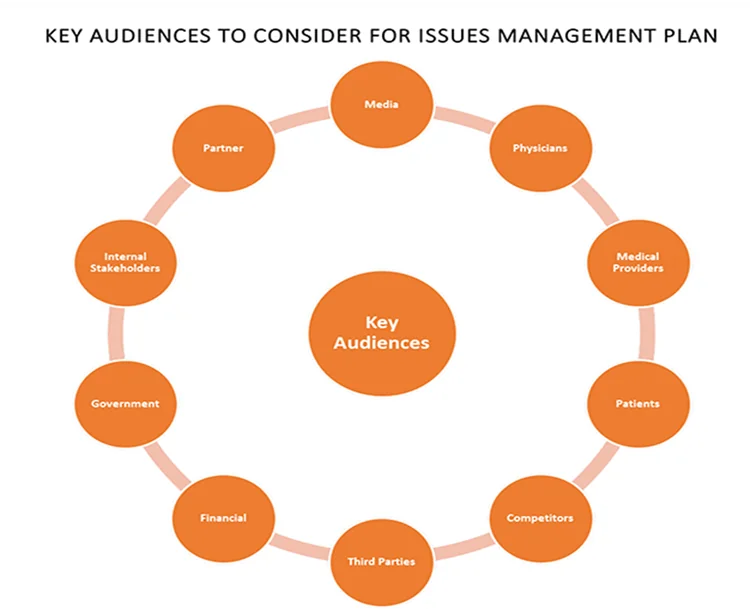Crisis Communications? Be Prepared.

Every health and science company inevitably faces risks and challenges that could morph into an actual crisis. Being prepared for crises can minimize negative publicity and reputational risks whether directly to the company or to the industry. Developing a list of potential risks or challenges is a great place to start when building out a crisis communications plan. Consider these examples:
- Misinterpretation of clinical results
- Clinical trial holds
- Regulatory actions/ CRLs
- Product liability
- Drug recalls
- Patent litigation
- Adverse press coverage
- Investor relations challenges
- Short sellers
Don’t underestimate the impact of social media when planning for crises. While it can improve communication, social media also has the potential to intensify a crisis. It provides a platform for anyone to share information—whether true or false—allowing misinformation to quickly gain traction and attract further attention.
Aligning and training management to deliver external and internal messaging using the right voice and channels allows the company to exercise reputation management by controlling the narrative.
As a matter of general prudence management should take the time to step back, try to foresee potential problems, from bumps in the road to existential threats, and based on this analysis to create as much structure as possible to guide the company’s response in the event of an emergency. Careful preparation goes a long way in mitigating damage.
In the health and science ecosystem, crisis communications are particularly complex, given regulations by the FDA, EMEA and SEC, not to mention protecting the health of patients. Here are six steps to help you prepare for a crisis.
- Understand the company’s key stakeholder audiences and their relative importance to the company; this list will vary depending on the size and stage of the company, but typically includes some or all of the following:
- Media
- Financial community and investors
- Healthcare providers
- Patients and advocacy organizations
- Strategic partners
- Third parties, industry organizations and professional societies
- Competitors
- Government and regulatory bodies
- Internal stakeholders
- Establish or add a section to your social media playbook on how to address crises.
- Develop an overall corporate message that is crisp and reflects your company’s mission, vision and values. Identify company spokespeople for each crisis scenario.
- Involve all internal players in crisis planning, including legal and regulatory counsel, medical affairs, product managers and other internal stakeholders. Allowing internal stakeholders to review and approve messaging and scheduling twice-yearly reviews ensure that your crisis plan is ready to go when needed.
- Train corporate spokespeople on credible message delivery. While the CEO is typically the key spokesperson, the CMO, CSO, or an external KOL may provide additional validation for scientific or medical concerns. And practice.
- Create general holding statements before a crisis hits that can be tailored to address a particular situation and that reflect the specific interests of different audiences.
When a Crisis Hits
When a crisis strikes, companies that have already created proactive crisis communications plans will be better positioned to navigate a difficult situation. Here are the actions management should take for an optimal crisis response.
- Verify all the facts so you know exactly what you are dealing with.
- Identify the degree of challenge that the crisis presents to tailor the response appropriately.
- Notify all relevant stakeholders, including the entire employee base, to ensure that only designated spokespeople respond on behalf of the company. This is especially crucial when it comes to communication on social media channels.
- Activate the crisis communications plan.
- Organize assignments and customize the necessary materials.
- Obtain final approvals for documents and statements from all internal stakeholders.
- Release the information to appropriate audiences through appropriate channels and appointed spokespeople.
- Obtain feedback and evaluate the response.
- Monitor events and highlight messaging as needed.
- Monitor trending content on your social channels and conduct a sentiment analysis on topics surrounding the crisis.
And beyond these logistical steps, keep in mind the softer nuances of a successfully managed crisis response.
- Be present for all stakeholders and constituents.
- Be credible, humble, empathetic, and honest – and take responsibility. Treat the media and the FDA as allies, not enemies.
- Use all communications channels to disseminate 360-degree, consistent messages.
- Continue to communicate as transparently as you can with key audiences.
Critical to navigating a crisis is to ensure you have an experienced team with skills specific to your needs. Click the following links to view our crisis communications case studies: Balancing Act Between Large, Multi-Nationals and Emerging, Growth Companies and Issues Management Proactive Planning on New Product Entrant
Contact us at hello@lavoiehealthscience.com for expert crisis planning services.
Share This Post

